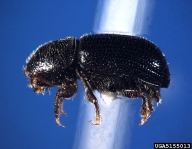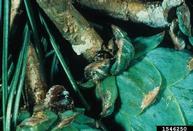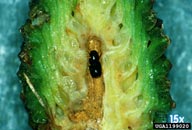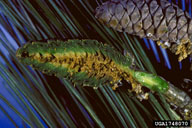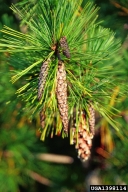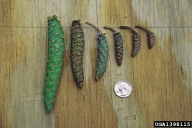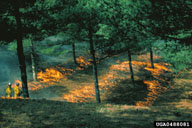White pine cone beetle
Conophthorus coniperda (Schwarz) (Coleoptera: Curculionidae, Scolytinae)
Orientation to pest
The white pine cone beetle, Conophthorus coniperda (Schwarz), infests cones of eastern white pine (Pinus strobus L.) and is an important pest of seed production in natural stands and in seed orchards. Cones are initially attacked by adult female beetles that start tunneling in the cone stalk or base. This severs the conductive tissue that connects the twig and cone, killing the cone. A small pitch tube generally marks the entry point. Individual female beetles extend an egg gallery down the central axis of a cone. Eggs are laid along this gallery. Larvae feed on seeds and associated tissues until they reach maturity. Larvae then pupate, and later emerge as adults, which darken over a few days. Development from egg to adult occurs in one growing season, and there is one generation per year. Female beetles can attack and oviposit in more than one cone. Infested cones stop growing in length after they are attacked. So, cones attacked in the early spring will be very small when they die, while cones attacked late in the summer are much larger in size. Infested cones shrivel, turn brown, and become hard. Because stalks of infested cones are severed, they can easily be removed by hand from a branch. Un-infested cones or cones attacked by other seed and cone insects, in contrast, adhere tightly to branches and may require a hand-clipper to remove. Infested cones eventually fall from trees, and beetles spend the winter within infested cones on the forest floor. In early spring, beetles chew emergence holes and fly from cones on the ground into tree crowns where they locate new host material. This is the most important pest of white pine seed orchards, sometimes destroying most or all of a developing seed crop. Damage is concentrated on second year cones, but first year conelets are also attacked. Beetles, when they are on the ground, can be killed using a low-intensity ground fire, a practice that is employed for control in seed orchards.
Hosts commonly attacked
Eastern white pine (P. strobus) is the only host of this species, but there are other species of Conophthorus associated with other pines.
Distribution
The white pine cone beetle is found throughout the range of eastern white pine, from eastern Canada (Quebec, Ontario, Nova Scotia), south to North Carolina, and west to Minnesota.
Images of white pine cone beetle
| Figure 1. Adult white pine cone beetle, Conophthorus coniperda | Figure 2. A female beetle can be seen initiating an attack at the base of a white pine cone where the cone stalk enters the cone | Figure 3. Egg-laying gallery of a cone beetle (Conophthorus sp.) in the center of a cone that has been cut in half |
| Figure 4. Damage inside a white pine cone caused by feeding of larvae of white pine cone beetle | Figure 5. Dead white pine cones, infested by larvae of white pine cone beetle may hang on trees for a period of time before dropping to ground | Figure 6. The length of dead infested cones can vary greatly. Small dead cones are those attacked in early spring and larger dead cones are those attacked in late summer. | Figure 7. Low intensity burns can be used in spring to control adults of white pine cone beetle before they emerge from cones on the ground |
Important biological control agents related to this pest species
Natural enemies of this insect have not been reported.
Articles
- Wade, D. D., G. L. Debarr, L. R. Barber, and E. Manchester. 1989. Prescribed fire - a cost effective control for white pine cone beetle, pp. 117-121. In: MacIver, D.C., H. Auld, and R. Whitewood (eds). Proceedings of the 10th Conference on Fire and Forest Meteorology. Forestry Canada, Petawawa National Forestry Institute (PNFI), Chalk River, Ontario.
- De Groot, P. 1990. The taxonomy, life history and control of Conophthorus (Coleoptera: Scolytidae) in eastern North America. Proceedings - Cone and seed pest workshop, 4 October 1989. Information Report N-X-274, Forestry Canada, Newfoundland and Labrador Region, St. John's, Newfoundland, Canada, pp. 37-46.
- Trudel, R., C. Guertin, and P. De Groot. 2004. Use of pityol to reduce damage by the white pine cone beetle, Conophthorus coniperda (Col., Scolytidae) in seed orchards. Journal of Applied Entomology 128: 403-406.
